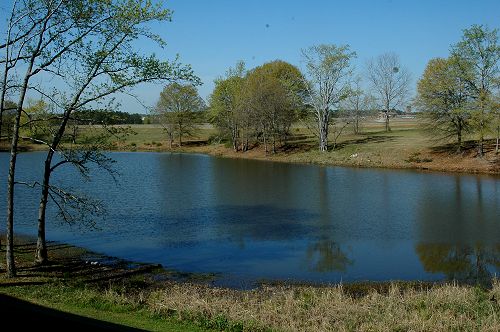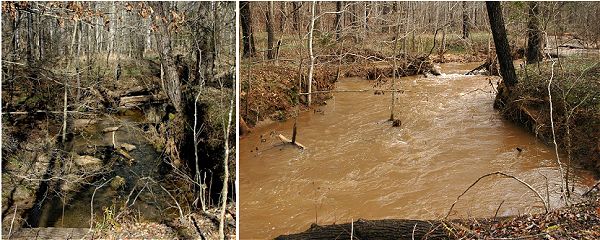Firefighter Weekend
Firefighter Weekend for 2007 is over now, and we're all apparently back safe and sound. The event was held at the Forsyth Georgia Public Safety Training Center campus, and went from Friday Mar 23 through Sunday Mar 25. Apparently 900 firefighters from around Georgia attended.
Seven of us from Wolfskin attended. Our usual Wolfskin festivities were fairly limited this year - some of us were there Fri-Sat, and some Sat-Sun, and our overlaps were infrequent. I think we can point out that the mean and median age of our Wolfskin contingent was somewhere around 52 years old. It would be nice to see that become lower rather than increase next year!
I'm not going to be able to offer much detail on the courses that I didn't take, since I haven't talked to our fellows much yet, but here's the breakdown:
Pat and Mike were there Fri-Sat, and took two courses, both of them very much physically involved. Friday was the course on getting out of bad situations, and I did catch the description of getting out of an upper story window onto a ladder quickly. Saturday was Pressurized Container, where you have the opportunity to approach a venting propane tank through a curtain of water with the goal of turning the very hot valve off.
David took the Saturday Pressurized Water Systems & Supplies course. I've taken this one two years ago so I know it's a fairly involved calculation course for figuring out what pressures to apply to hoses of different sizes and hooked up in different configurations and situations, so that you can get good flow from all outlets.
The rest of us were there Sat-Sun, and it was rather lonely without the other three around. Indeed, Sunday was pretty dead in general - it looks like most folks did the Fri-Sat courses.
Louis and Ed took the course on Preparing for the Initial Attack at a Scene (I can't remember the precise title). This is going to be particularly important, since it undoubtedly involves strategy - strategy that has to be summed up within minutes of reaching a scene. We're going to have to pick their brains over this one.
And Glenn and I took the Incident Safety Officer course. I can go on and on about this - it was a good solid course and meshes well, I think, with Louis and Ed's selection.
“Incident Safety Officer” is a two-day complex introductory course that addresses something we as a department don’t really have, and should. The basic message is that all incident responses need to be mounted with restrictions informed by safety and risk issues. This philosophy has now permeated all levels of firefighting response to the extent that the Safety Officer has veto power over the Incident Commander’s plan, though we were cautioned that exercising that kind of power should be wielded with caution, lest powerful personality conflicts emerge.
One of the disconnects that we always feel a little bit of was always in evidence, although the instructors are aware of it and do their best to address everyone’s concerns. Indeed they do a very good job of covering the field for everyone; I have to admit that. This is, of course, that most of the class consists of professionals who train every day and run into incidents all the time. That’s in contrast to us volunteers, who train (in our case) four times a month, and have maybe as many incidents in that time. It’s a huge safety issue, since it’s riskier for volunteers who are not constantly practicing and honing their techniques and responses. The risks for volunteers are higher for everything, but especially driving personal vehicles to and from the station, driving a firetruck to and from a fire, and heart attacks.
The “current issues” section of the course was especially interesting. Wildland firefighting was treated, not particularly well, we discovered, but then we’ve had the 40-hour course last June and in this one instance probably knew more than the instructor (indeed we had a particular bone to pick with him, and Glenn did later, in private). There were emphases on roadway incidents that are particularly important for us, and a section on terrorist incidents. The latter was something that I had a vague set of preconceptions about, but now I realize the potential is somewhat greater than I had recognized, and the complexities of response much more involved.
The potential is greater because the majority of terrorist incidents are domestic, and can involve assaults just about anywhere - family planning clinics, alternative lifestyles gathering places, and religious institutions (their words, not mine) were listed as targets. And the complexities involved included the potential for secondary attacks, once responders get there: a secondary bomb placed at a fire hydrant in one of the Atlanta bombings was actually something that our instructor had encountered. While not strictly an example of the latter, we also went over booby-trapping, and it is relevant in Georgia because of the large number of home-style meth labs that are being encountered. In that case milk jugs filled with gasoline had been tied with fishing line above and hidden by the room ceiling, so that in the event of a fire or discovery, they would drop onto the responders below, and ignite.
Last but not least, here's an image of a very small part of the campus, as viewed from our dorm room. Our dorm room, however functional (and do they really use old kevlar vests to stuff their pillows with?), came this year with a western view of one of the several ponds on campus. There was turtle action in the evening, and a pair of geese guarding a nest in the foreground wetland grasses:

I'm impressed by the GPSTC campus every time I see it. A drive through campus, perhaps going from one complex to another, can net a number of strange sights. That drive is going to take awhile, but you do NOT want to exceed the 25 mph speed limit, not here. This is not *just* a firefighting academy - it is a complex of training centers for every facet of public safety.
Over there is the bombing range, but I suspect they don’t use that during a specialized weekend like ours, at least, we’ve never witnessed any bombs going off. Over that hill are two entangled cars frozen in mid-wreck, and yes, they are there for extrication training. If you’re lucky, you might see a 300-foot plume of flame shooting into the air, and that would be the pressurized container course that Pat and Mike took. And that road leads to the mock village, where all sorts of terrible things happen to the mock inhabitants.
Over beyond the far-away building in the background of the above photo, unseen, is the inmates' complex, for this campus is also a prison, primarily for youthful offenders. It’s fairly minimum security, and the inmates do most of the day-to-day operations - they bus tables in the cafeteria, clean the dorm rooms during the day, do much of the upkeep on the campus, and even run the fire station for the campus. You’re not supposed to interact in any way with them, there are lockers in the dorm rooms where you have to lock in all your items before leaving for the day, and handguns and alcohol are not permitted on campus.
All in all, a great weekend that at least gave me a big boost. It's always like that - the usual reluctance for signing up weeks ahead, the angst just before driving off for a lost weekend, and then afterward everything is wonderful and it was completely worthwhile. As I should have known in the first place!
--Wayne



